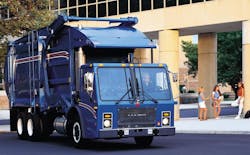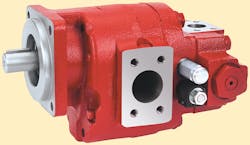Most of us associate utilities with our monthly bills for gas, phone, electricity, and water. However, waste management is an important utility as well, and many residents now find themselves billed for garbage collection in addition to periodic sewage services. Hydraulics, of course, plays a vital role in trash collection by arming carefully engineered trucks with the power to perform multiple functions of waste collection. Front loading trucks have become commonplace to lift large, heavy dumpsters and dump their contents into the truck’s large storage bin. There, packing mechanisms compress the trash with other bulk waste so more payload can be carried. This is repeated until the bin reaches its holding capacity. Modern waste handling vehicles can service 1000 or more houses per day. The more productive the equipment is, the less the cost to individual residents.
Stroking a hydraulic packer may not seem very complicated, but remember:
- this equipment doesn’t sit still for very long, so the pump is subjected to a wide range of engine and vehicle speeds,
- packer loads are varied and uneven,
- the hydraulic system must operate in a wide range of temperatures, and
- the operators are in a hurry because they have additional tasks, so the packer controls must be simple and relatively fool-proof.
Many existing packer designs deal with these operating parameters by segregating travel and packing functions so only one can function fully at a time. This may mean that the vehicle can’t move until the packing cycle is completed and vice versa. Components such as throttle lockouts, electronic or hydraulic overspeed controls, special flow controls, or dry valves are added to the packing circuit to accomplish this.
Pump system packs in energy savings
Muncie Power Products Inc., offers a different solution — the MLS Series M Live-Pack pump system. This system is designed to be the heart of a waste handling vehicle’s hydraulic system, supplying flow for all the actuators involved, and helping the solid waste industry meet productivity goals.
Typically driven off the engine crankshaft, the Live-Pack pump runs continuously but delivers hydraulic flow only on demand when the operator trips a switch. An integral solenoid valve activates the pumping system when the hydraulics are required to operate. Once on, the system operates in a normal fashion.
The Live-Pack pump is matched to the specific vehicle for efficiency and productivity. An orifice plug limits maximum discharge flow to the system; once the required flow has been met, excess oil bypasses to tank. Designers size and select both the pump and the proper-size orifice plug to suit the application.
With the Live-Pack system, the operator has full control of the hydraulics at all times. Packer efficiency is maximized by allowing operators to pack trash while driving the pump at higher engine speeds. With the flow-limiting orifice, cycle times are maintained, and the userfriendly system never shuts down due to overspeed or excess flow. There is no waiting for the packer blade to complete its cycle because hydraulic flow never is interrupted.
The design incorporates load-sensing gear pump technology — with which most service personnel are familiar. It has fewer working components (no overspeed control, throttle lockout, or speed limiters) than conventional systems, thus reducing potential maintenance problems even further. The pump has an integral non-adjustable safety-relief valve to provide backup protection for the system’s primary relief if a malfunction occurs. The patented design also includes unload features that help reduce engine fuel consumption due to its low power draw. Pressures in the standby mode are typically less than 25 psi. This also reduces system heat generation while in standby mode.
Six models of the MLS Series M Live Pack pump cover a flow range from 22 to 44 gpm at 1000 rpm. Pressures to 3000 psi and speeds to 2500 rpm, along with several shaft and flange options, provide the versatility to meet many application and installation needs. For retrofit situations, the pump easily can be adapted into existing systems with either minimal or no changes. None of the other major hydraulic components has to be changed or removed.
Fleets are reporting 10 to 15% productivity gains on equipment fitted with MLS Series M Live-Pack pump systems when compared to other pump systems and controls. Multiplied out into days and weeks, the savings and productivity gains add up impressively.
Larry Wesley is product manager, hydraulic systems, at Muncie Power Products Inc., Muncie, Ind. Contact him at lwesley@munciepower. com, or visit www.munciepower.com for more information.



